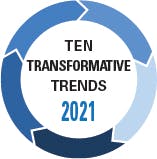One trend that has become marked in the past few years, but that perhaps remains underappreciated, is this: that independent multispecialty physician groups are moving ahead of hospital-based health systems in taking on two-sided risk. It is not so much that the fact of that trend in itself is shattering or even surprising; but some of the implications involved are significant.
The reality, of course, is that the leaders of hospital-based organizations still have to fill beds, and that they have very high overhead costs compared to clinics and physician practices. And given that the vast bulk of reimbursement to hospitals remains discounted fee-for-service payment, the incentives remain very complicated and layered for hospital-based health systems.
Things remain rather a mixed picture on the ground. In the January-February issue of this publication, we presented results from our State of the Industry Survey. With regard to value based contracts, survey respondents reported the following: 35 percent were involved in the Medicare Shared Savings Program (MSSP), 22 percent were involved in the Next Generation ACO (accountable care organization) program, 27 percent were involved in a Medicaid ACO; and 42 percent were involved in an ACO with one or more private health insurers. Still, only 4 percent of respondents reported that more than 20 percent of their overall reimbursement involved two-sided risk. Meanwhile, 4 percent said that 15 to 20 percent involved two-sided risk; 18 percent said that 10 to 15 percent of their reimbursement involved two-sided risk; 12 percent said that 5 to 10 percent involved two-sided risk; and 22 percent said that 0 to 5 percent of their reimbursement involved two-sided risk.
Nevertheless, say industry experts and observers, the reality is that both the Biden administration and Congress will inevitably be stepping hard on the gas pedal around value-based reimbursement in the coming year or two, as the alternative is unpalatable—large provider reimbursement cuts. So how will this all play out?
Christopher Kerns, vice president, executive insights, at the Washington, D.C.-based Advisory Board, puts it this way: “Right now, the Medicare Hospital Trust Fund is expected to go into deficit in 2024, or possibly even as early as 2023. And Congress will have to address it, most likely because new borrowing might not address it. So Congress will likely double down on value-based payment, rather than either cutting reimbursement or raising taxes.”
Asked to comment on the ongoing and very public battle of wills that played out last year between the leaders of NAACOS (the Washington, D.C.-based National Association of ACOs) and Seema Verma, the Administrator of the federal Centers for Medicare and Medicaid Services (CMS), over some of the parameters around benchmarks and risk in the Medicare Shared Savings Program for ACOs, Kerns says this: “My sense of that tension is that the providers that are pushing back had better hope that downside risk works, because the alternative is huge payment cuts. There were lots of changes under the Obama administration, but when it came to value-based care, it was more evolutionary than revolutionary. The one difference between the Trump administration and the Obama administration is that the Trump administration people valued performance over participation. And frankly, some of the programs developed were designed to increase primary care physician (PCP) participation, in order to decrease referrals to specialists. If you look at why Seema Verma was pushing hard on downside risk, upside-only risk doesn’t generate a lot of savings, but does encourage hospital-physician partnerships. So hospitals are trying to navigate wanting to collaborate with physicians, but at the same time maintaining referrals to inpatient care. If you expect the Biden administration to be more like the Obama administration, it will mean that they’ll favor participation over performance. But there’s an equally strong chance that they’ll double down on what the Verma team did.” In that context, he says, more hospital-based organizations will inevitably enter into two-sided risk contracts as the market dynamics shift and encourage doing so.
“Hospitals have definitely been slower to get into two-sided risk; there’s no doubt about it,” Kerns says. But, he adds, it’s important to understand the incentives being put in place by payers. “This isn’t just a Medicare thing; it’s Medicare, Medicaid, and private payers, all for different reasons. But there’s this confluence of consensus that physician-led risk-based contracting is the way to go. For private payers, the logic is that they can send members to lower-cost providers. For Medicare, it’s outpatient versus inpatient. So you’re either sending patients to a lower-priced facility or to a lower-intensity site of care.”
One element, Kerns says, remains a stumbling block: “Physicians, especially PCPs, don’t have large fixed costs; so for them, every admission or hospital-based procedure averted is shared savings that accrues to them directly and personally. Meanwhile, hospitals have extremely high levels of costs that have to be paid down. And fee-for-service is a lot easier to manage. So when you have huge fixed-cost assets to pay down, you go for what’s easier, which is more fee-for-service encounters, rather than ensuring a wider catchment of patients assigned to you, and keeping them out of inpatient. It’s not that hospitals have anything but the best interests of patients in mind, but they have ORs and staff, and have to cross-subsidize a lot of operational costs that frankly, primary care physicians just don’t have to do.” Still, in the next two years, he says, “You’ll see all payers pushing more downside risk onto all providers. So you’ll see Medicare Advantage [MA] growing significantly over the next couple of years. Just remember, with ACOs, you might achieve savings, but it’s not so certain, whereas MA has a lot more certainty, because of the risk adjustment scores, so physicians can more accurately prospectively prepare for their risk, whereas in ACOs, it’s retrospective.”
Elements involved in moving into risk
Meanwhile, what are some of the elements playing an active role in the calculations of provider organizations of all kinds, in choosing to get involved in two-sided risk? “Whether you’re a multispecialty group practice, a large integrated system, or anywhere in between, you’re looking for a couple of things before moving into risk, says Darryl Drevna, senior director, regulatory affairs, at the Alexandria, Va.-based AMGA (American Medical Group Association). “First, do you have the population to support it? How many covered lives do we have? The other thing is stability in the framework around the regulations that manage these programs. Per the MSSP, there’s been a whole lot of shifting in terms of what’s expected, under Pathways to Care. In this latest round of rulemaking, they made fairly significant changes to how providers have to report on quality. And those are major for providers, because they have to dig in and figure out whatever they need to change care delivery models, workflows, staffing; you can’t turn these ships around in mid-ocean.”
Meanwhile, those organizations pushing for payment innovation will continue to do so; certainly, Drevna says, AMGA will be in that group of providers. “AMGA and its membership will continue to go towards value-based and population health-based models, because there’s really no alternative,” he says. “That said, what HHS [the Department of Health and Human Services] is going to do in this area will depend on who’s staffing HHS, how we come out, post-pandemic, and what our capacity is. But we’re going to keep moving ahead, and I’m going to be working to make sure that HHS and Congress see us.”


